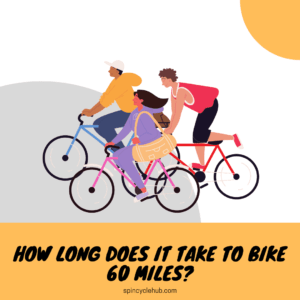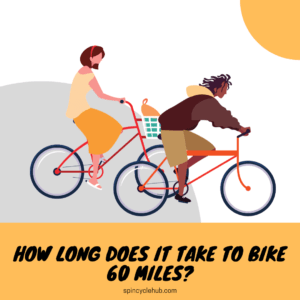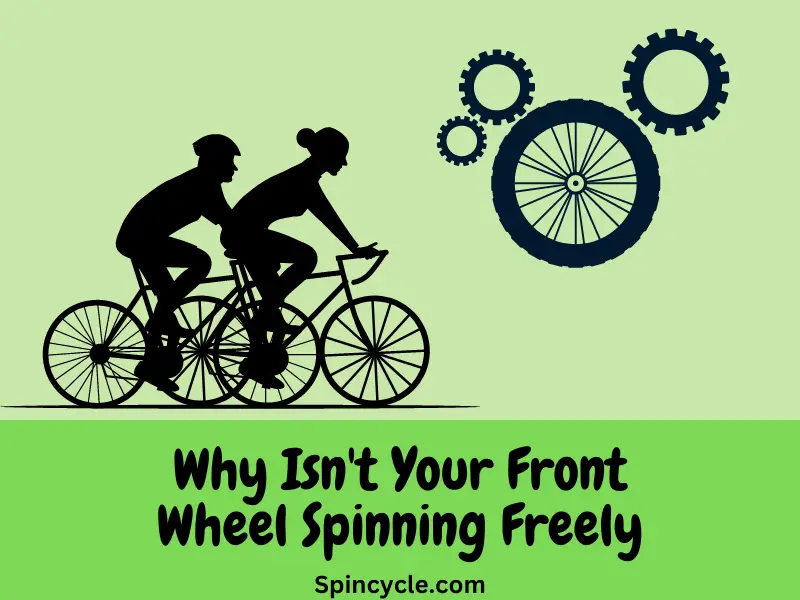Introduction
Hey there, fellow cycling enthusiast! So, you’ve got your eyes set on conquering the 60-mile mark on your bike, huh? That’s a fantastic goal! But before you hit the road, it’s natural to wonder, “How long is this adventure going to take?” Well, fret not, because I’m here to spill the beans on what you can expect. Get ready for a ride through the twists and turns of biking 60 miles.

I. Setting the Stage: Factors Affecting Biking Speed
Terrain and Elevation
Picture this: you’re cruising along a flat, smooth road, and you’re flying! The miles seem to disappear beneath your tires. But then, the road starts to climb, and it feels like you’re pushing a boulder uphill. That’s the power of terrain and elevation on your biking speed. If your route is flat as a pancake, you’ll cover 60 miles faster than if you’re tackling the rolling hills of the countryside. I remember a ride through the hills where every incline felt like a mountain, and it seriously slowed me down.
Weather Conditions
Mother Nature has a way of throwing surprises at us, especially when we’re on two wheels. Wind, rain, and temperature can make a massive difference in your biking speed. Ever tried to pedal against a headwind that feels like a brick wall? It’s no picnic! Plus, rain can turn your ride into a slippery adventure. One time, I got caught in a downpour that turned my clothes into a sopping mess. Not the best day for speed, let me tell you.
Bike Type and Condition
Your trusty steed matters too. If you’ve got a sleek road bike built for speed, you’ll naturally go faster than if you’re on a heavy mountain bike meant for rough trails. And don’t forget bike maintenance. A well-tuned bike with properly inflated tires can make a world of difference. I once upgraded my bike, and it felt like I had swapped a tricycle for a Ferrari. The difference was astonishing.
II. The Pace that Sets the Pace: Average Biking Speeds
Cruising Speed vs. Sprinting Speed
When you’re out there, it’s essential to understand the difference between cruising speed and sprinting speed. Cruising speed is that comfortable pace where you can chat with fellow riders and enjoy the scenery. Sprinting speed is when you’re giving it your all for short bursts of time. Knowing when to switch between these gears is crucial. I remember a race where I burned out too early by sprinting too much in the beginning. Lesson learned: pace yourself!
Typical Speed Range for Cyclists
Now, let’s talk numbers. What’s the average speed for a cyclist? Well, it varies. Leisurely riders might cruise at 10-12 miles per hour. Recreational cyclists can hit 15-18 miles per hour. And if you’re a competitive rider, you might be zooming along at 20-25 miles per hour or more. Personally, I was thrilled when I reached a consistent 15 miles per hour on my rides.
III. Crunching the Numbers: Calculating Biking Time
Simple Math: Miles per Hour
Here comes the math part. To figure out how long it takes to bike 60 miles, you’ll need to know your average speed. It’s a simple formula: time = distance ÷ speed. Let’s say you can maintain a steady 15 miles per hour. If you divide 60 miles by 15 miles per hour, you’ll get 4 hours. So, at that speed, it’ll take you 4 hours to complete your 60-mile journey. Easy, right?
Real-Life Application
But wait, real life isn’t always as straightforward as math equations. When I planned my first 60-mile ride, I had all the calculations down, but I didn’t account for the gorgeous countryside I’d be passing through. I kept stopping to snap photos, chat with locals, and soak in the beauty. So, even though my math said 4 hours, the actual ride took me closer to 5 hours. It’s essential to balance the numbers with the real-world experience.
IV. Personalizing the Journey: Your Unique Factors
Fitness Level and Training
Your personal fitness level plays a massive role in how long your ride will take. If you’ve been training regularly and building your endurance, you’ll breeze through those 60 miles more quickly. I remember starting as a beginner and gradually working up to longer distances. It’s amazing how your body adapts and becomes more efficient with time.
Rest Stops and Breaks
Don’t forget to factor in breaks! Rest stops are not only a chance to refuel with snacks and water but also to give your muscles a breather. I’ll never forget this one time when I stumbled upon a picturesque lake during a break. I couldn’t resist dipping my toes in, and it added a precious memory to the ride, even if it extended the journey a bit.
V. Navigating Challenges: Dealing with Unexpected Delays
Traffic and Urban Obstacles
If your route takes you through a bustling city, you’ll encounter traffic lights, stop signs, and congestion. These urban obstacles can slow you down considerably. I once had a city ride where I felt like I was stopping at every intersection. It felt like I was on a never-ending tour of red lights!
Mechanical Issues
Ah, the dreaded flat tire or chain mishap. It happens to the best of us. I’ve had my share of roadside tire changes and chain re-threading adventures. When these setbacks occur, it’s crucial to stay calm and composed. Being prepared with the right tools can make a big difference. Trust me; it’s better to spend a few extra minutes fixing your bike properly than rushing and making it worse.
VI. Mental Game: Staying Motivated and Focused
Mind over Mileage
Now, let’s talk about the mental aspect of biking 60 miles. There will be moments when you question your decision to embark on this journey. You might feel tired, sore, or just mentally fatigued. That’s when you need to summon your inner cyclist ninja. I’ve been there, pushing through mental barriers, and it’s incredibly rewarding when you do.
VII. The Homestretch: Finishing Strong
Managing Energy Reserves
As you approach the final stretch of your 60-mile adventure, managing your energy reserves becomes crucial. You want to finish strong, not crawl across the finish line. Keep an eye on your nutrition and hydration throughout the ride. It can make all the difference in those last miles. I’ll never forget the sense of accomplishment when I saw the finish line approaching. It was a mix of exhaustion and triumph that I’ll cherish forever.
Celebrating Milestones
Crossing that 60-mile mark is a milestone worth celebrating. It’s not just about the destination; it’s about the journey itself. The challenges you overcame, the sights you saw, and the memories you created along the way are what make it truly special.

Conclusion
In conclusion, how long it takes to bike 60 miles is a blend of various factors: terrain, weather, bike quality, your fitness level, and even your mental fortitude. Don’t get
too hung up on the numbers; instead, savor the experience. Embrace the unexpected moments, push through the challenges, and relish in the sense of accomplishment when you reach that 60-mile mark.
FAQs
1. Can I bike 60 miles in one go if I’m a beginner?
– Starting with shorter distances and gradually building up your endurance is a safer approach for beginners. Give your body time to adapt to longer rides.
2. What’s the best type of bike for a 60-mile ride?
– A road bike is generally the preferred choice for long-distance rides due to its lightweight design and efficiency on paved roads.
3. How can I improve my biking speed and endurance?
– Consistent training, incorporating interval workouts, and focusing on both strength and endurance exercises can help enhance your biking performance.
4. Should I be concerned about hydration and nutrition during the ride?
– Absolutely! Staying properly hydrated and fueling your body with the right nutrients is crucial for a successful and safe long-distance ride.
5. What’s the most important thing to remember when attempting a long-distance ride?
– Listen to your body. Pay attention to signs of fatigue or discomfort, and take breaks when needed. Safety and enjoyment should always come first.
- Bicycling.com: How to Plan Your First Century Ride
- This link provides valuable tips and advice for planning and executing a 100-mile (century) ride, which can be a helpful resource for those aspiring to tackle a 60-mile ride.
- Strava.com: Cycling Tips for Beginners
- Strava offers a variety of articles and tips for cyclists of all levels, including beginners. It covers topics like training, nutrition, and gear, which can be beneficial for someone preparing for a long-distance ride.
Watch this one,
Video Credits – queer cyclist
DOWNLOAD THIS ARTICLE :Click Here
You May Also Like



